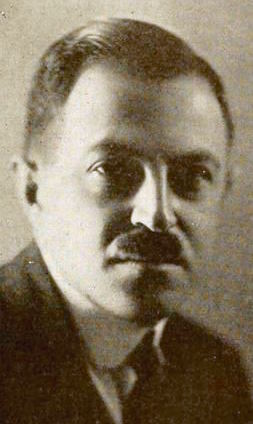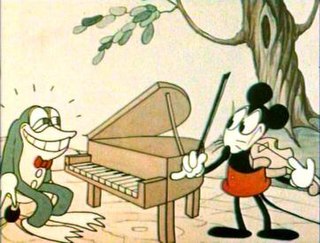
Animation is a filmmaking technique by which still images are manipulated to create moving images. In traditional animation, images are drawn or painted by hand on transparent celluloid sheets (cels) to be photographed and exhibited on film. Animation has been recognized as an artistic medium, specifically within the entertainment industry. Many animations are computer animations made with computer-generated imagery (CGI). Stop motion animation, in particular claymation, has continued to exist alongside these other forms.

Ubbe Ert Iwerks, known as Ub Iwerks, was an American animator, cartoonist, character designer, inventor, and special effects technician, known for his work with Walt Disney Animation Studios in general, and for having worked on the development of the design of the character of Mickey Mouse, among others. Born in Kansas City, Missouri, Iwerks grew up with a contentious relationship with his father, who abandoned him as a child. Iwerks met fellow artist Walt Disney while working at a Kansas City art studio in 1919.

The golden age of American animation was a period in the history of U.S. animation that began with the popularization of sound synchronized cartoons in 1928, gradually ending in the 1960s when theatrical animated shorts started to lose popularity to the newer medium of television. Animated media from after the golden age were produced on cheaper budgets and with more limited animation techniques between the 1960s and 1970s. The theatrical animation of the golden age peaked in the 1930s and 1940s, while the period is subdivided as the silver age for the rest of its animation produced in the 1950s and 1960s; which includes the latest theatrical animations produced by Walt Disney and Walter Lantz, the latest theatrical cartoons of MGM and Warner Bros., Hanna-Barbera's earliest animated television series and DePatie–Freleng's earliest theatrical cartoons. Furthermore, the history of animation became very important as an artistic industry in the United States.

Fleischer Studios was an American animation studio founded in 1929 by brothers Max and Dave Fleischer, who ran the pioneering company from its inception until its acquisition by Paramount Pictures, the parent company and the distributor of its films. In its prime, Fleischer Studios was a premier producer of animated cartoons for theaters, with Walt Disney Productions being its chief competitor in the 1930s.

Max Fleischer was a Polish-American animator, inventor, film director and producer, and studio founder and owner. Born in Kraków, Poland, Fleischer immigrated to the United States where he became a pioneer in the development of the animated cartoon and served as the head of Fleischer Studios, which he co-founded with his younger brother Dave. He brought such comic characters as Koko the Clown, Betty Boop, Popeye, and Superman to the movie screen, and was responsible for several technological innovations, including the rotoscope, the "follow the bouncing ball" technique pioneered in the Ko-Ko Song Car-Tunes films, and the "stereoptical process". Film director Richard Fleischer was his son.

Flip the Frog is an animated cartoon character created by American animator Ub Iwerks. He starred in a series of cartoons produced by Celebrity Pictures and distributed by Metro-Goldwyn-Mayer from 1930 to 1933. The series had many recurring characters, including Flip's dog, the mule Orace, and a dizzy neighborhood spinster.
While the history of animation began much earlier, this article is concerned with the development of the medium after the emergence of celluloid film in 1888, as produced for theatrical screenings, television and (non-interactive) home video.

Traditional animation is an animation technique in which each frame is drawn by hand. The technique was the dominant form of animation in cinema until the end of the 20th century, when there was a shift to computer animation in the industry, specifically 3D computer animation.
The Computer Animation Production System (CAPS) was a proprietary collection of software, scanning camera systems, servers, networked computer workstations, and custom desks developed by The Walt Disney Company and Pixar in the late 1980s. Although outmoded by the mid-2000s, it succeeded in reducing labor costs for ink and paint and post-production processes of traditionally animated feature films produced by Walt Disney Animation Studios (WDAS). It also provided an entirely new palette of digital tools to the animation filmmakers.
ComiColor Cartoons are a series of twenty-five animated short subjects produced by Ub Iwerks from 1933 to 1936. The series was the last produced by Iwerks Studio; after losing distributor Metro-Goldwyn-Mayer in 1934, the Iwerks studio's senior company Celebrity Pictures had to distribute the films itself. The series was shot exclusively in Cinecolor.

Myron "Grim" Natwick was an American artist, animator, and film director. Natwick is best known for drawing the Fleischer Studios' most popular character, Betty Boop.
Alfred Julius Eugster was an American animator, writer, and film director. He worked for a number of American animation studios, including Fleischer Studios, the Iwerks Studio, Walt Disney Productions, and Famous Studios.
Color Classics are a series of animated short films produced by Fleischer Studios for Paramount Pictures from 1934 to 1941 as a competitor to Walt Disney's Silly Symphonies. As the name implies, all of the shorts were made in color format, with the first entry of the series, Poor Cinderella (1934), being the first color cartoon produced by the Fleischer studio. There were 36 shorts produced in this series.
James H. "Shamus" Culhane was an American animator, film director, and film producer. He is best known for his work in the Golden age of American animation.
Character animation is a specialized area of the animation process, which involves bringing animated characters to life. The role of a character animator is analogous to that of a film or stage actor and character animators are often said to be "actors with a pencil". Character animators breathe life in their characters, creating the illusion of thought, emotion and personality. Character animation is often distinguished from creature animation, which involves bringing photorealistic animals and creatures to life.

Popeye the Sailor Meets Sindbad the Sailor is a 1936 two-reel animated cartoon short subject in the Popeye Color Specials series, produced in Technicolor and released to theatres on November 27, 1936, by Paramount Pictures. It was produced by Max Fleischer for Fleischer Studios and directed by Dave Fleischer, with the title song's music composed by Sammy Timberg and lyrics written by Bob Rothberg. The voice cast includes Jack Mercer as Popeye, Gus Wickie as Sindbad the Sailor, Mae Questel as Olive Oyl and Lou Fleischer as J. Wellington Wimpy.

Popeye the Sailor Meets Ali Baba's Forty Thieves is a two-reel animated cartoon short subject in the Popeye Color Specials series, produced in Technicolor and released to theatres on November 26, 1937 by Paramount Pictures. It was produced by Max Fleischer for Fleischer Studios, Inc. and directed by Dave Fleischer. Willard Bowsky was head animator, with musical supervision by Sammy Timberg. The voice of Popeye is performed by Jack Mercer, with additional voices by Mae Questel as Olive Oyl, Lou Fleischer as J. Wellington Wimpy and Gus Wickie as Abu Hassan.

Gulliver's Travels is a 1939 American animated musical fantasy film produced by Max Fleischer and directed by Dave Fleischer for Fleischer Studios. Released to cinemas in the United States on December 22, 1939, by Paramount Pictures, the story is a very loose adaptation of Jonathan Swift's 1726 novel of the same name, specifically only the first part of four, which tells the story of Lilliput and Blefuscu, and centers around an explorer who helps a small kingdom who declared war after an argument over a wedding song. The film was Fleischer Studios' first feature-length animated film, as well as the second animated feature film produced by an American studio after Walt Disney Productions' Snow White and the Seven Dwarfs, as Paramount had commissioned the feature in response to the success of that film. The sequences for the film were directed by Seymour Kneitel, Willard Bowsky, Tom Palmer, Grim Natwick, William Henning, Roland Crandall, Thomas Johnson, Robert Leffingwell, Frank Kelling, Winfield Hoskins, and Orestes Calpini.
The second wave of Walt Disney Treasures was released December 3, 2002. This was the final wave with the tin's individual number embossed on the tin.
Iwerks Studio was an animation studio headed by animator Ub Iwerks.













